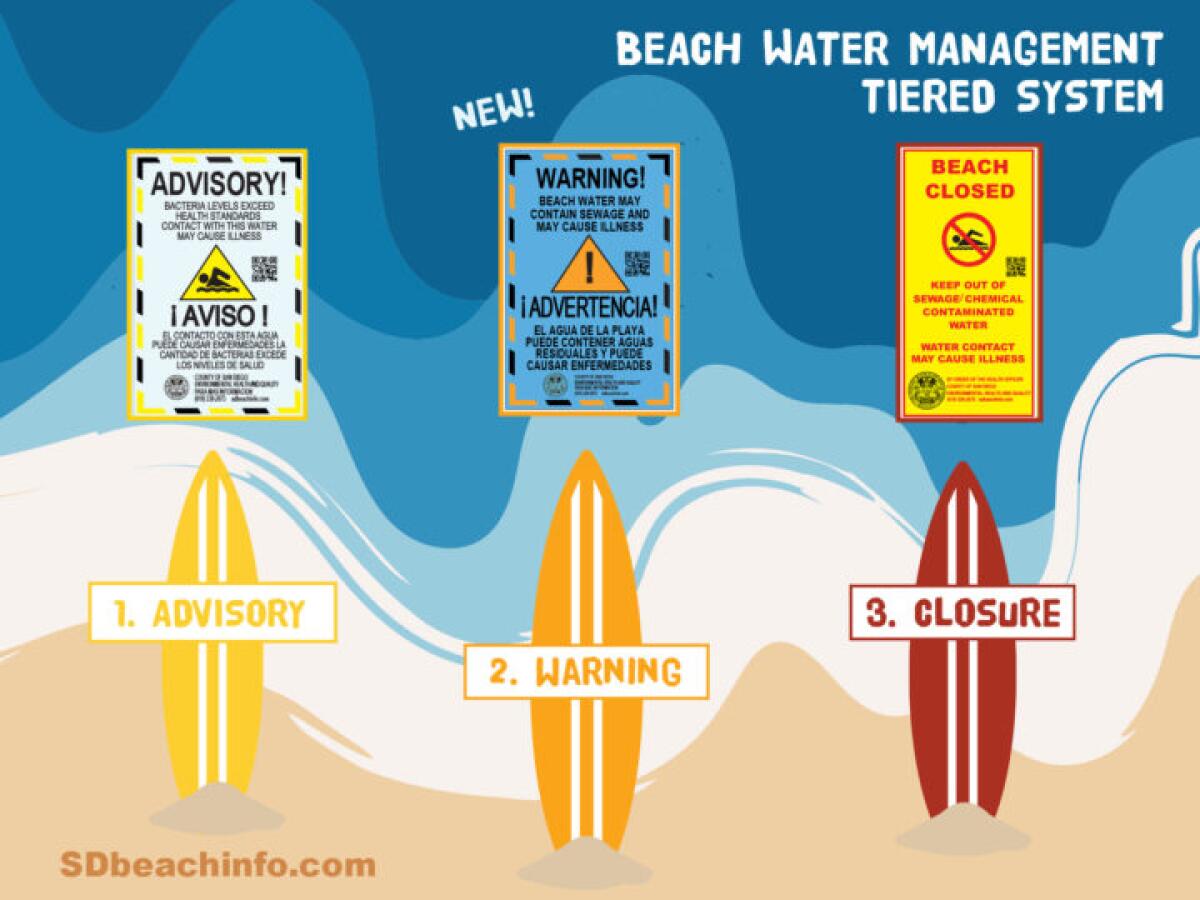Coronado beaches could see new ‘warning’ signs for Tijuana sewage over Fourth of July weekend

- Share via
SAN DIEGO — Public health officials are predicting ocean currents heading north, known as south swells, could carry plumes of raw sewage spewing from a defunct wastewater plant in Baja California as far as Coronado over the holiday weekend.
However, visitors and residents may not see the familiar yellow “Beach closed” signs — which were posted in the sand from the border to Coronado as of Wednesday evening.
County leaders are rolling out new signage starting Friday for some pollution events that give swimmers discretion over whether to get in the water. The blue placards will read: “Warning! Beach water may contain sewage and may cause illness.”
“There might be sewage impacts, but we don’t know that for sure,” said Elise Rothschild, former director of the county’s Department of Environment Health and Quality, who is now working with the agency on a contract basis. “We want to let the public know that a south swell could lead to potential impacts so they can make their own decision.”

The new warning protocol will largely be reserved for the spring and summer, when testing can reveal the presence of fecal bacteria, but sewage often cannot be seen or smelled in the water, county officials said. Contamination during the fall and winter that results from heavy rains or burst pipes in Tijuana will still trigger closures.
Exposure to bacteria and viruses in human waste can result in diarrhea, fever, respiratory disease, meningitis and even paralysis, according to public health officials.
The new approach comes after San Diego County rolled out a DNA-based ocean quality test in early May. Leaders in Imperial Beach and Coronado were shocked to see their shorelines abruptly shuttered as a result of the more sensitive monitoring technology.
Coronado Mayor Richard Bailey pushed back on the closures earlier this year, questioning whether public health was actually at risk. The county’s new discretionary approach to beach closures was cold comfort for the public official, who fears his city’s tourism industry could suffer over the typically busy Fourth of July weekend.
“This new test and closure-warning threshold for beaches is not actually protecting the public, but it is creating a false perception that the beaches are less safe this summer than previous summers, which is simply untrue,” Bailey told the San Diego Union-Tribune on Wednesday.
Imperial Beach Mayor Serge Dedina said the county’s recent decision took him by surprise. His city’s shoreline has been closed for all but three days since the new testing went into effect.
“I haven’t had time to talk to the lifeguards about this to make sure what it really means,” he said. “As usual, the county didn’t communicate with the city about this.”
For years, environmental regulators thought sewage spilling into San Diego from Mexico was largely a wintertime occurrence, driven by heavy rains and flows in the Tijuana River.
However, last year, a report by UC San Diego’s Scripps Institution of Oceanography, Stanford University and the U.S. Environmental Protection Agency confirmed what many surfers had long suspected: The San Antonio de los Buenos Wastewater Treatment Plant at Punta Bandera is discharging millions of gallons of raw sewage into the ocean, creating plumes that routinely float up the coastline.
The EPA has drafted a $630-million blueprint to stem the cross-border pollution, which would reroute much of the wastewater currently pumped to Punta Bandera to the South Bay International Wastewater Treatment Plant along the border in San Diego. The agency recently launched an environmental review of the plan, which is expected to break ground in the next three to five years.
Current beach closures can be tracked at sdbeachinfo.com.
More to Read
Sign up for Essential California
The most important California stories and recommendations in your inbox every morning.
You may occasionally receive promotional content from the Los Angeles Times.














